10 Authentic Vegetarian Foods of Switzerland
By guest author Tara
Switzerland is known for its mountains, cows, and chocolate, which doesn’t seem like the ideal place for vegans and vegetarians but there are still some traditional foods that are tasty and free from animal products. Most foods of Switzerland are hearty, high in carbohydrates, and consist of things that preserve well. This is because Swiss farmers traditionally spend their days in the Alps herding cows. So, would have to carry their food for the day, or heat it up on fire in the evening. Nowadays dairy farming is still a huge industry and animal by-products are found in many authentic Swiss dishes. This creates many more options for vegetarians than vegans, but gradually the market is offering greater vegan options.
Below are the most authentic Swiss dishes that are vegetarian or can be made vegan-friendly.
1. Rosti
This is the go-to traditional dish for vegans in Switzerland. Rosti is a dish originating in the canton of Bern and eaten by farmers for breakfast, but today you will see it all over Switzerland more often for lunch and dinner. It is a dish made from shredded potatoes, baked until crispy, and often topped with various ingredients. Most commonly you will have Swiss cheese melted on top with a fried egg, but it also comes with roast veggies or tomatoes. It is simple to add and subtract the toppings, so can be altered to fit any diet, and is always filling.
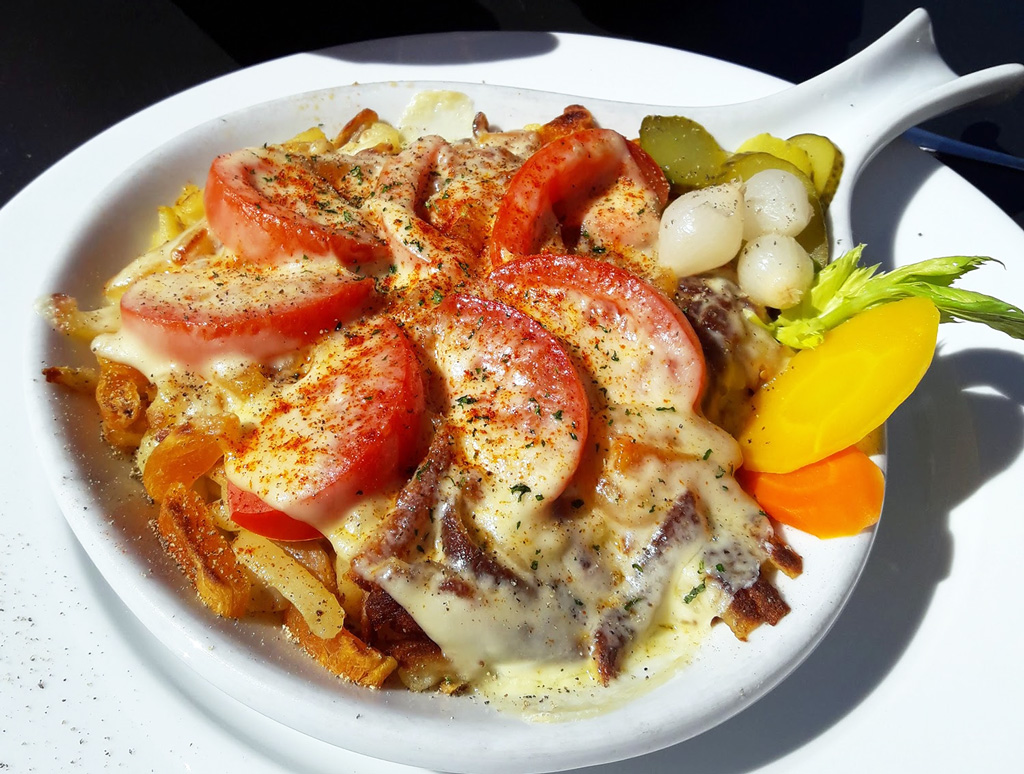
2. Bircher Muesli
Muesli is an alpine favourite start to the morning. You have probably heard of the dry granola-like breakfast cereal that you add milk on top of, well Bircher Muesli is similar but already has the milk in it. A Swiss Doctor named Bircher recommended what we know as overnight oats over a century ago, as he promoted grains and fruit to be included in a healthy diet. The mixture is made of milk or yogurt mixed with fresh fruits, mostly apples, pears, and raisins with oats, and left to sit a few hours or overnight to get all soaked together. Many hotels can offer a vegan version of Bircher Muesli made with oat or soy milk if you ask in advance.

3. Cheese Fondue
This is the main dish that everyone thinks of when they imagine authentic Swiss food. However, fondue is only eaten in the winter months, and usually at home. The cheese fondue is said to have come about when monks in the alps were fasting during lent and only allowed themselves liquids. So with so much cheese sitting around, the cheese fondue was born!
The typical cheese fondue is a authentic vegetarian food of Switzerlan. The classic cheese fondue recipe contains Gruyere cheese and half Emmentaler cheese, mixed with a bit of flour, white wine, garlic, and a splash of the national liquor, Kirsch. There are now many different types of cheese fondue, including blue cheese, mushroom flavor, and even a brand that makes cheese-less cheese fondue, called “no moo due”!
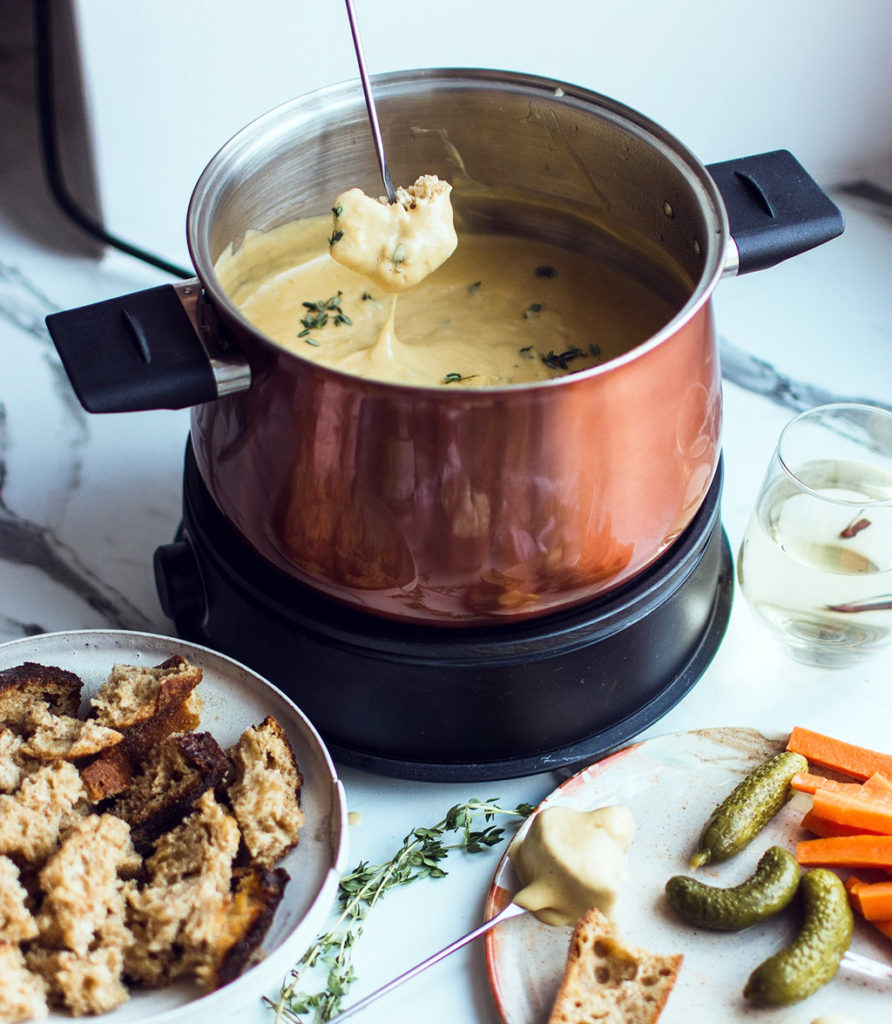
4. Gerstensuppe (Swiss Alp Barley Soup)
Gerstensuppe is a hearty Swiss Alps barley soup that originates in the canton of Graubunden. It is so ubiquitous now that you will find it in every alpine restaurant while hiking in the summer or skiing in the winter. Gerstensuppe is a colorful, chunky, and healthy option made from pearl barley and seasonal vegetables, and most often vegan in Switzerland.
Sometimes restaurants top Swiss barley soup with bacon or ham, but more often than not this is the fresh made daily soup which is the vegan option, as more and more people ask for it. Each recipe differs a little, but you know you will be full after a bowl of this alongside a hunk of fresh bread.
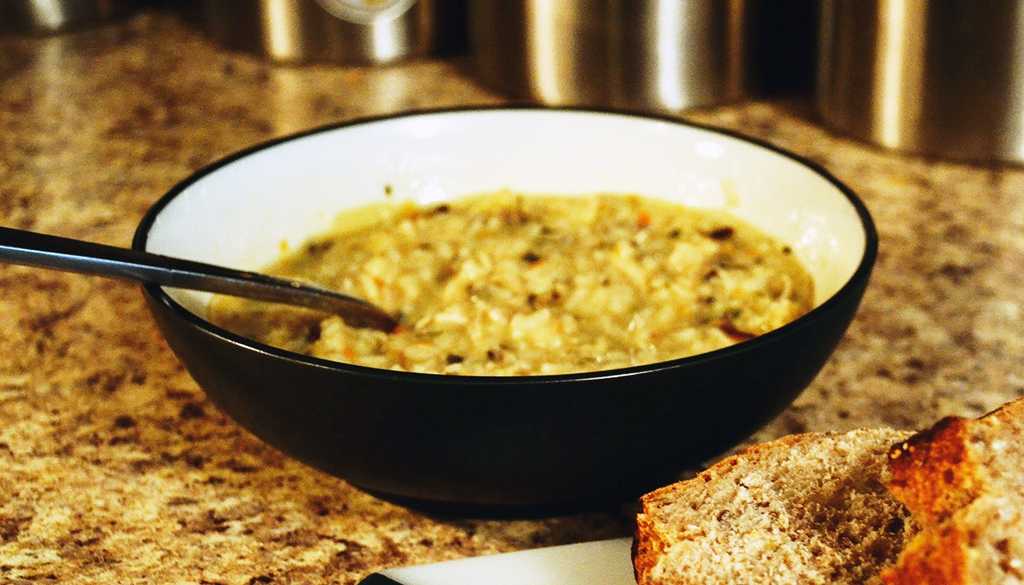
5. Alpen Macaroni
Älplermagronen is like a Swiss version of mac and cheese, but depending on where you are in Switzerland the recipes vary a little. Typically Alpen Macaroni dish is made with macaroni pasta, potatoes, and of course a cheese sauce, topped with crispy onions and apple sauce. However it is made in a different sort of way, where they measure the exact amount of water needed for the pasta to make everything in one pot, and the potatoes slowly become part of the cheese sauce.
Alpen macaroni dish is sometimes garnished with bacon or bits of sausage, so just double-check the ingredients or ask for it without.
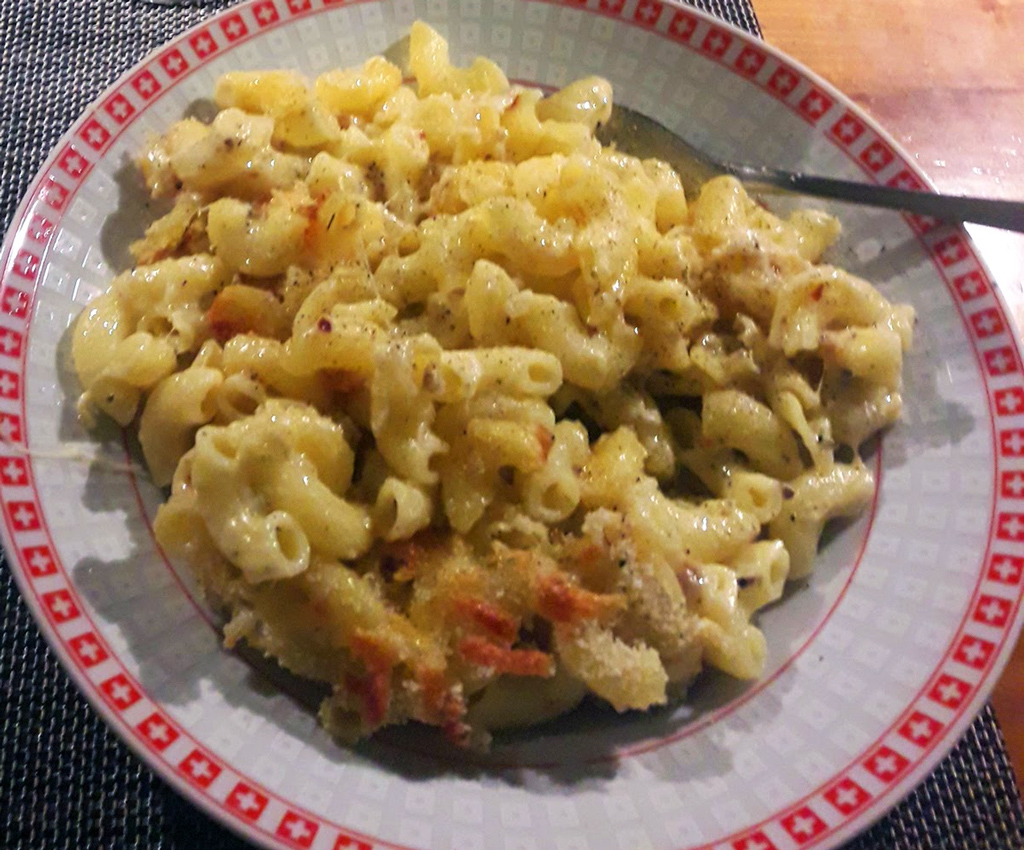
6. Wild Garlic Pesto or Ravioli
Every year in the spring, the forest floor of Switzerland becomes covered in wild garlic, locally known as Bärlauch. The flavor is quite strong and so fresh that you can smell it if you are walking past it. So many people bring bags to gather wild garlic as they go hiking. Once gathered, the most common thing to do with all the garlic is to make the pesto by chopping it up with oil and pine nuts. The wild garlic pesto is used in pasta, or to make a delicious filling for ravioli. The flavor is fresh and quite strong so the pasta doesn’t need any other ingredients, but don’t be surprised if some Swiss places top it with cheese just like everything else!

7. Nussgipfel
Gipfel is the word for a croissant in Switzerland, and a nussgipfel is a croissant stuffed with a sweet nutty filling. Nussgipfel, a vegetarian food of Switzerland, can be found in every bakery and convenience shop around the country. It does contain butter in the croissants, so not exactly vegan, but a scrumptious morning treat or after-hike snack for vegetarians. Switzerland uses a lot of nuts in its cuisine. Nussgipfel recipe is made from hazelnuts mixed with cream and sugar to get a soft sweet filling. Switzerland loves its sweet pastries. Most bakeries in Switzerland have a selection of gipfels, including the mandelgipfel (with almonds), volkhorngipfel or rusticgipfel (whole wheat), and the plain buttergipfel.

8. Raclette
Raclette is another cheese dish that is typical to Switzerland. The Swiss love their cheese and have a special way to eat each different kind. Raclette is a social and do-it-yourself-style event like fondue that can take all evening. Traditionally a large piece of raclette cheese was placed near the fire and then farmers would scrape off the top melted part onto bread and potatoes. Today most people use a raclette machine that sits on your table and has little trays for everyone to melt their own cheese and then scrape it onto their plates.
Raclette is accompanied by boiled potatoes and sometimes other vegetables as well as onions and gherkins, which help you to digest the cheese. This is similar to the chasbrot, which is when one person melts a wheel or very large chuck of cheese until it is crispy and then scrapes it onto a piece of bread. Chasbrot is found in markets and food stalls and served more as a snack, whereas raclette is a sit self-serve dinner.
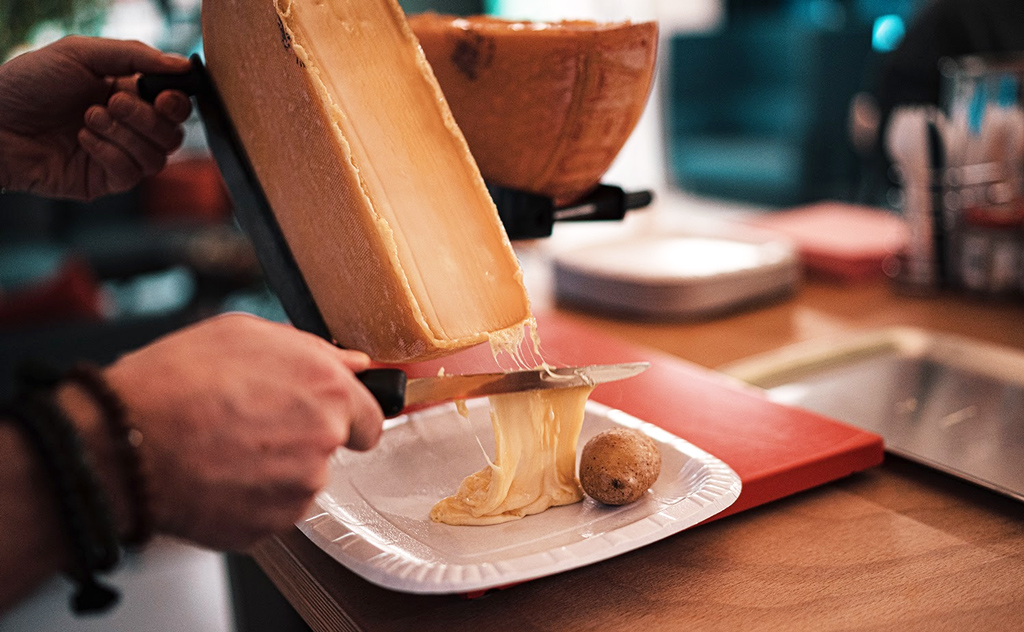
9. Süssmost
Apples are another prime ingredient in Swiss cooking, you will find apple tarts, cakes, pasta, and mixed into everything else as it goes great with cheese. And Swiss drinks are mostly vegan! Autumn is the apple harvesting time in Switzerland. This is when you will find fresh-pressed juice and ciders available everywhere. Most or Moscht is the name for the liquid made from apples, but there are many different types that go under the names of sussmost for non-alcoholic cider, so more like cloudy apple juice, and sauremost or suuremost which is the alcoholic type of apple cider, and then schorle is when the juice is mixed with sparkling water. All of them are well worth a try and available in any shop or restaurant throughout the year.
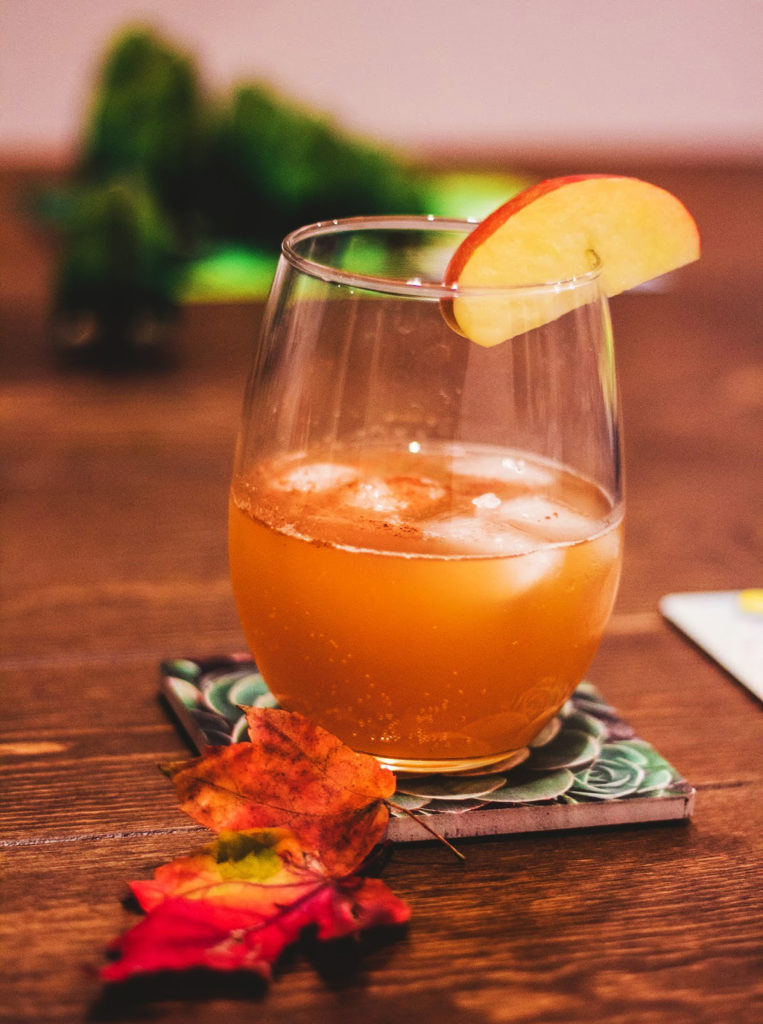
10. Chocolate!
It is difficult to talk about Swiss food and not mention chocolate. Milk chocolate was created in Switzerland. The Swiss continue to make it to the highest quality just like everything else they do. Cocoa had existed in Europe for some time before the Swiss began to mix it with sugar and milk, but this combination made chocolate as we know it today.

Since the 1800’s Switzerland has been making luxury chocolate and is now known all over the world for it. Now the Swiss even make some varieties that are dairy-free, so you can still try premium Swiss chocolate as a vegan.
So as you can see, traditional Swiss cuisine is easier for vegetarians as Switzerland is a large dairy producing country. Cheese is often the center point in Swiss dishes, but they always have a selection of sides to go with it. Swiss food is served in large portions and is always filling, whether it is a soup or a side. Food in Switzerland is made to replenish you after a long hike. Apples, pickles, onions, grains and bread will be found on every menu in various combinations, along with a selection of sweets and snacks that won’t leave you hungry. Swiss cuisine is continuously adapting to accommodate different diets. The ability to substitute milk or cheese with vegan options opens up many more typically Swiss dishes for vegetarians.
About the Author
Tara is the travel blogger behind Tara’s Travels, a website dedicated to helping travelers make the most of their trips by feeling like a local. Tara’s adventurous spirit and love of nature got her exploring the world from a young age, and she has now visited over 30 countries. Tara has been a vegetarian for 20 years so knows the challenge of wanting to try new foods within a restricted diet. When not traveling,
Tara is based out of the Swiss Alps, where she can hike, ski, and play with her Cambodian street cat.
Awesome Food Ideas for Vegans
- Traveling as a Vegan or Vegetarian
- Barcelona’s vegan and vegetarian foods
- Barcelona’s Vegetarian pintxos in Barcelona
- Italian vegetarian dishes and our 9-day trip
- Portugal’s vegetarian foods
- Lisbon’s Pastel de Nata
- Malta’s vegetarian foods on our 5-day trip
- Taiwan’s vegan foods
- Marathi village food on Sinhagad fort
- South Florida’s Vegetarian food choices
- London’s Borough Food Market on our 6-day trip

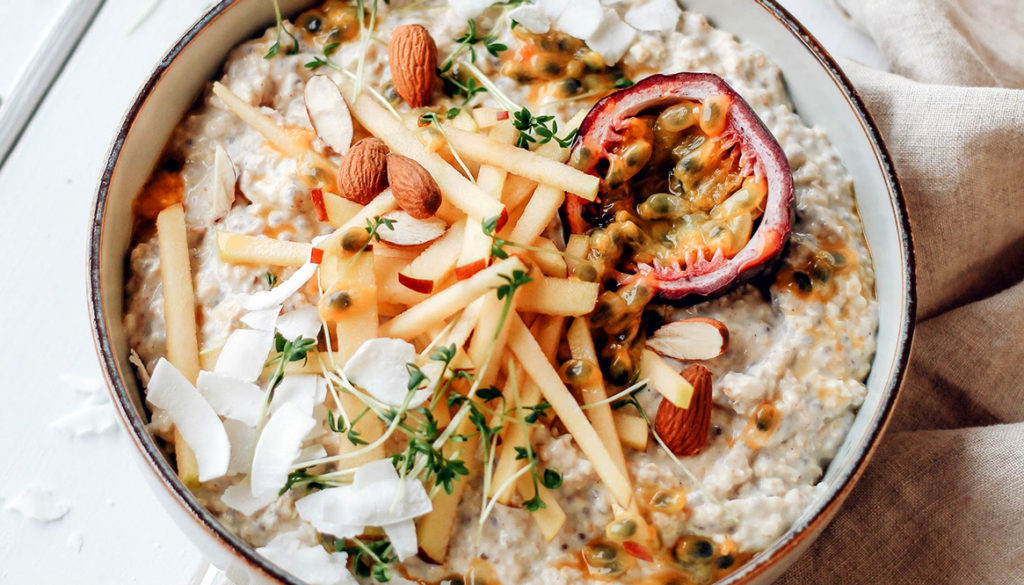
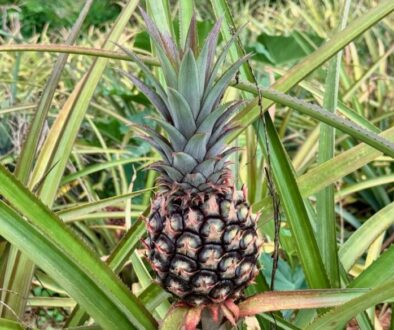



Sue Harris
February 28, 2022 @ 6:23 pm
Be careful with cheese. Traditionally it is made with rennet which comes from the stomach of slaughtered young calves. This makes quite a few dishes you mention here quite unsuitable for vegetarians. There are cheeses made with vegetarian rennet, but this is the exception rather than the norm. Vegusto cheese is a vegan Swiss cheese and worth looking out for.
Mina
May 10, 2022 @ 4:54 am
We’re a group of volunteers and starting a new scheme in our community. Your site offered us with valuable information to work on. You’ve done an impressive job and our entire community will be thankful to you.